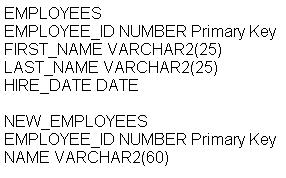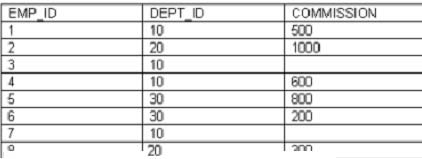Oracle 1z0-051 Exam Practice Questions (P. 3)
- Full Access (290 questions)
- One Year of Premium Access
- Access to one million comments
- Seamless ChatGPT Integration
- Ability to download PDF files
- Anki Flashcard files for revision
- No Captcha & No AdSense
- Advanced Exam Configuration
Question #11
Which statement correctly describes SQL and /SQL*Plus?
- ABoth SQL and /SQL*plus allow manipulation of values in the database.
- B/SQL*Plus recognizes SQL statements and sends them to the server; SQL is the Oracle proprietary interface for executing SQL statements.
- C/SQL*Plus is a language for communicating with the Oracle server to access data; SQL recognizes SQL statements and sends them to the server.
- DSQL manipulates data and table definitions in the database; /SQL*Plus does not allow manipulation of values in the database.
Correct Answer:
A
A
send
light_mode
delete
Question #12
Which four are types of functions available in SQL? (Choose 4)
- Astring
- Bcharacter
- Cinteger
- Dcalendar
- Enumeric
- Ftranslation
- Gdate
- Hconversion
Correct Answer:
BEGH
SQL have character, numeric, date, conversion function.
Incorrect answer:
ASQL have character, numeric, date, conversion function.
CSQL have character, numeric, date, conversion function.
DSQL have character, numeric, date, conversion function.
FSQL have character, numeric, date, conversion function.
Refer: Introduction to Oracle9i: SQL, Oracle University Study Guide, 3-3
BEGH
SQL have character, numeric, date, conversion function.
Incorrect answer:
ASQL have character, numeric, date, conversion function.
CSQL have character, numeric, date, conversion function.
DSQL have character, numeric, date, conversion function.
FSQL have character, numeric, date, conversion function.
Refer: Introduction to Oracle9i: SQL, Oracle University Study Guide, 3-3
send
light_mode
delete
Question #13
Examine the structure of the EMPLOYEES and NEW_EMPLOYEES tables:

Which MERGE statement is valid?

Which MERGE statement is valid?
- AMERGE INTO new_employees c USING employees e ON (c.employee_id = e.employee_id) WHEN MATCHED THEN UPDATE SET
- Bname = e.first_name ||','|| e.last_name WHEN NOT MATCHED THEN INSERT value S(e.employee_id, e.first_name ||', '||e.last_name);
- CMERGE new_employees c USING employees e ON (c.employee_id = e.employee_id) WHEN EXISTS THEN UPDATE SET
- Dname = e.first_name ||','|| e.last_name WHEN NOT MATCHED THEN INSERT valueS(e.employee_id, e.first_name ||', '||e.last_name);
- EMERGE INTO new_employees cUSING employees e ON (c.employee_id = e.employee_id) WHEN EXISTS THEN UPDATE SET
- Fname = e.first_name ||','|| e.last_name WHEN NOT MATCHED THEN INSERT value S(e.employee_id, e.first_name ||', '||e.last_name);
- GMERGE new_employees c FROM employees e ON (c.employee_id = e.employee_id) WHEN MATCHED THEN UPDATE SET
- Hname = e.first_name ||','|| e.last_name WHEN NOT MATCHED THEN INSERT INTO new_employees valueS(e.employee_id, e.first_name ||', '||e.last_name);
Correct Answer:
A
this is the correct MERGE statement syntax
Incorrect answer:
Bit should MERGE INTO table_name
Cit should be WHEN MATCHED THEN -
Dit should MERGE INTO table_name
Refer: Introduction to Oracle9i: SQL, Oracle University Study Guide, 8-29
A
this is the correct MERGE statement syntax
Incorrect answer:
Bit should MERGE INTO table_name
Cit should be WHEN MATCHED THEN -
Dit should MERGE INTO table_name
Refer: Introduction to Oracle9i: SQL, Oracle University Study Guide, 8-29
send
light_mode
delete
Question #14
Which view should a user query to display the columns associated with the constraints on a table owned by the user?
- AUSER_CONSTRAINTS
- BUSER_OBJECTS
- CALL_CONSTRAINTS
- DUSER_CONS_COLUMNS
- EUSER_COLUMNS
Correct Answer:
D
view the columns associated with the constraint names in the USER_CONS_COLUMNS view.
Incorrect answer:
Atable to view all constraints definition and names
Bshow all object name belong to user
Cdoes not display column associated
Eno such view -
Refer: Introduction to Oracle9i: SQL, Oracle University Study Guide, 10-25
D
view the columns associated with the constraint names in the USER_CONS_COLUMNS view.
Incorrect answer:
Atable to view all constraints definition and names
Bshow all object name belong to user
Cdoes not display column associated
Eno such view -
Refer: Introduction to Oracle9i: SQL, Oracle University Study Guide, 10-25
send
light_mode
delete
Question #15
The COMMISSION column shows the monthly commission earned by the employee.
Exhibit -

Which two tasks would require sub queries or joins in order to be performed in a single step? (Choose two.)
Exhibit -

Which two tasks would require sub queries or joins in order to be performed in a single step? (Choose two.)
- Alisting the employees who earn the same amount of commission as employee 3
- Bfinding the total commission earned by the employees in department 10
- Cfinding the number of employees who earn a commission that is higher than the average commission of the company
- Dlisting the departments whose average commission is more that 600
- Elisting the employees who do not earn commission and who are working for department 20 in descending order of the employee ID
- Flisting the employees whose annual commission is more than 6000
Correct Answer:
AC
AC
send
light_mode
delete
All Pages
